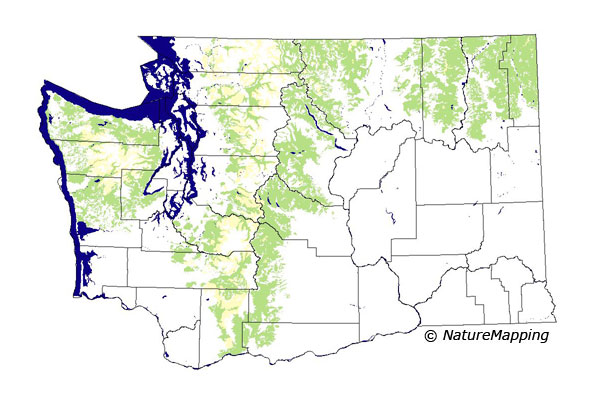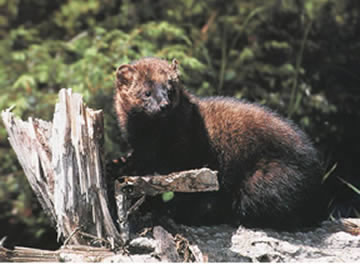
NatureMapping Animal Facts
Fisher
|
Fisher (Martes pennanti)
Local names: Pacific fisher, black cat, fisher cat, pekan, pequam, wejack, and woods-otter. 
Description: Fishers are small dark brown mammals - about the size of a house cat. Fishers are similar to the much smaller weasels. They have a long body with short legs, rounded ears, and a bushy tail. Males are often larger than females. Their thick coats range from medium to dark brown, with gold to silver hoariness (fine whitish hairs) on their head and shoulders, and with black legs and tail. Fishers have five toes with retractable claws - like a cat - making them agile and excellent climbers. 
A Fisher is a bigger, stronger, and darker version of its cousin, the marten. The Fisher has the same general long and low–slung weasel-like body shape as the Marten, but it is larger and stockier, with thicker fur and a flatter face. Fishers are members of the weasel family (Mustelidae), related to martens, minks and otters.
Range / Habitat: In western forests, Fishers are found in late-successional conifer forests with a high percentage of canopy closure, abundant large woody debris, large snags and cavity trees, and understory vegetation. The Fisher is now rare in Washington and limited mostly to dense, preferably mature, forest, although second growth with good cover may also be used. In 2008, Fishers were released in into the Olympic National Park in Northwest Washington. (see Proposed Fisher Reintroduction) Click the range map to learn more about the historical distribution of Fishers in Washington. Diet: Fishers are carnivorous (eat meat) -- they primarily eat mice, porcupines, squirrels, snowshoe hares, birds, and shrews. Like other carnivores, they also feed on fruits and berries, including beechnuts and apples. Behavior: Fishers are secretive and rarely observed in the wild. Young fishers are raised in dens found in rotting logs or tree cavities. Sometimes females will move their young - several times - if the litter is disturbed by potential predators. Male fishers do not help raise their young. Fishers communicate with each other by scent marking. They have good senses of hearing, smell, and sight. The Fisher is the only predator to have a specialized killing technique for Porcupines. They repeatedly bite and scratch at the Porcupine's face to cause it to bleed to death. Because most of the porcupine is mostly covered in quills, the Fisher flips the dead animal over, to eat its prey. Fishers also prey upon eggs and young of Spotted owls in the nest. Reproduction: Very little is known about the mating habitats of fishers. Female Fishers first breed at one year of age. The breeding season for the Fisher begins in late February and lasts until mid-April. Implantation of the blastocyst phase of the embryo is delayed approximately ten months. Following implantation, gestation lasts for around 30 days. Birth thus occurs nearly one year later, just prior to mating. Litter sizes generally range from one to four, but can be as high as five or six in rare cases. Young Fishers are born blind and almost completely naked. Their eyes open after about 53 days. They are protected and raised in a hollow tree by their mother. Lifespan/Longevity: Fishers can live up to ten years in the wild. Conservation Status: Currently, the Fisher is very rare in Washington. Infrequent sighting reports and incidental captures indicate that a small number may still be present. However, despite extensive surveys, no one has been able to confirm the existence of a population in the state (WDFW). The Fisher is limited to extensive tracts of relatively undisturbed, late-successional forest - including old-growth forests. "The west coast population of the Fisher is endangered mainly due to the loss and fragmentation of habitat due to timber harvest, roads, urban development, recreation, and wildfires. Other threats include small population sizes and isolation, predation, and human-caused mortality from vehicle collisions, poaching, and incidental capture and injury." (U.S. Fish and Wildlife Service) In the recent past, Fishers were trapped and killed for their pelts. Fishers are beneficial since they hunt Porcupines, and help to control Porcupine populations (Porcupines damage timber crops by debarking and killing trees). There are ongoing efforts, by state and federal wildlife biologists, to reintroduce Fishers to the Olympic National Park. Read The Seattle Times article Weasel-like fisher back in state after many decades.
Did you know?
More information:
References:
Animal silhouettes available to purchase » |